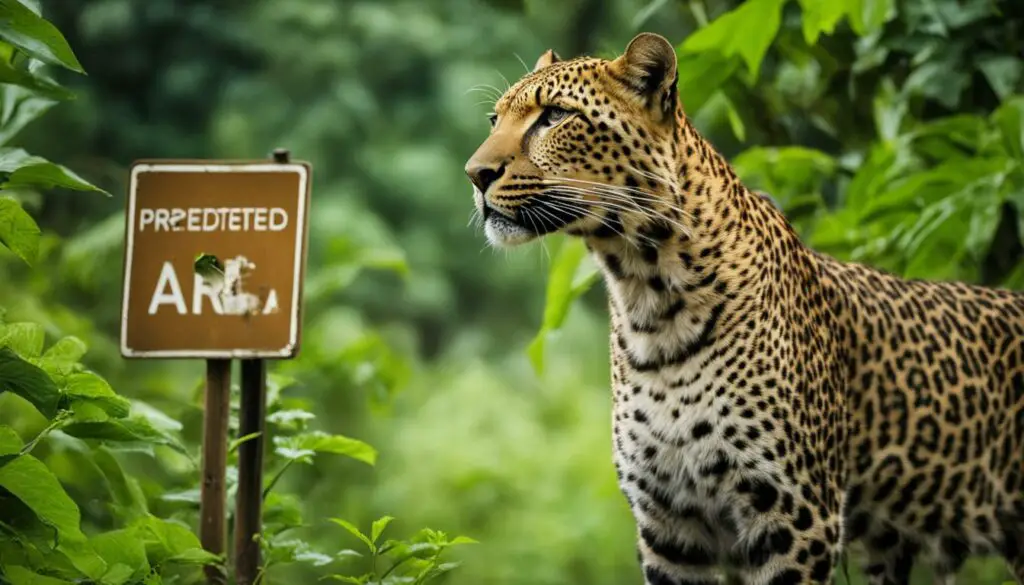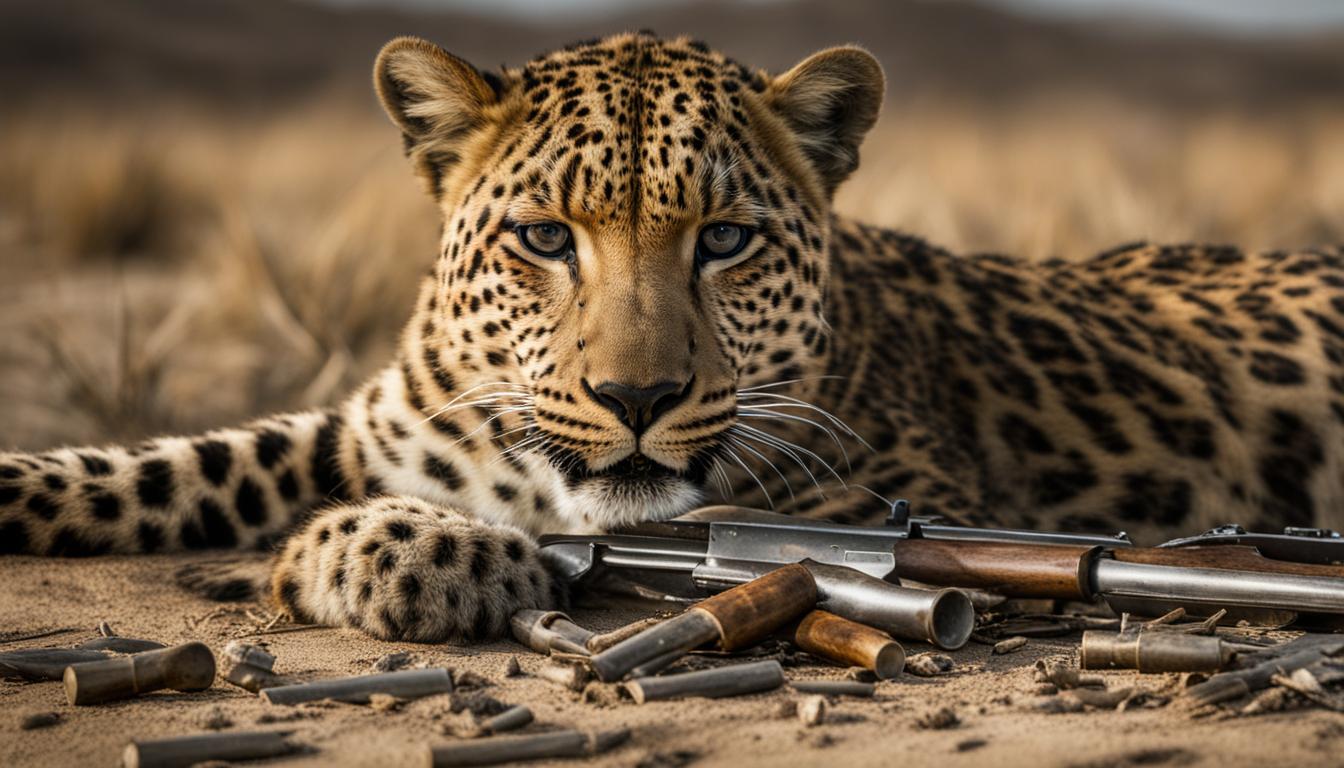Welcome to our article on the conservation status of leopard populations. In this section, we will discuss the current situation and the challenges faced by these magnificent creatures. Let’s delve into the details and understand the efforts being made to protect these endangered species.
The Impact of Human Activities
Human activities, such as habitat loss and fragmentation, are major contributors to the decline in leopard populations. Deforestation, urban development, and conversion of land for agriculture have resulted in the loss of suitable leopard habitats. This loss of habitat has led to the fragmentation of populations, making it difficult for leopards to move and disperse. Additionally, the decline in prey species due to hunting and competition has also affected leopard populations.
Table: Factors Contributing to Leopard Population Decline
| Factors | Description |
|---|---|
| Habitat Loss and Fragmentation | Deforestation, urban development, and land conversion have led to the loss and fragmentation of leopard habitats. |
| Prey Decline | The decline in prey species due to hunting and competition has affected the availability of food for leopards. |
The impact of human activities on leopard populations is significant and requires urgent attention. Conservation efforts must focus on addressing the root causes of habitat loss and prey decline to ensure the long-term survival of these endangered wildlife species.
Conservation Efforts
Conserving endangered species like leopards requires the collective efforts of various organizations dedicated to wildlife conservation. These organizations work tirelessly to protect leopard populations and their habitats, employing a range of strategies to ensure their survival in the face of numerous threats.
The Panthera Foundation is a leading organization in leopard conservation, focusing on scientific research and implementing conservation projects in partnership with local communities and governments. Their programs aim to address key issues such as habitat loss, human-wildlife conflict, and illegal hunting. Through their initiatives, the Panthera Foundation plays a crucial role in raising awareness about the importance of protecting leopard populations and mobilizing support for conservation efforts.
Another notable organization is the Leopard Trust, which focuses on research and monitoring to gain a better understanding of leopard behavior, population dynamics, and the impacts of human activities. Their work helps inform conservation strategies and policies, ensuring more effective measures are put in place to safeguard leopard populations.
The African Wildlife Foundation (AWF) is also actively involved in leopard conservation. Their approach combines community engagement, habitat protection, and anti-poaching initiatives. By working closely with local communities and supporting sustainable livelihoods, the AWF promotes coexistence between humans and leopards, reducing the pressures that drive conflict and endanger leopard populations.
Threats to Leopard Populations
Leopard populations are facing significant threats from illegal wildlife trade and poorly managed trophy hunting. The demand for leopard skins and body parts in traditional medicine and luxury markets has fueled the illegal wildlife trade, leading to the poaching and killing of these majestic creatures. This trade poses a grave risk to leopard populations, as it disrupts their natural habitats and contributes to their decline.
Poorly managed trophy hunting is another threat to leopard populations. Trophy hunting involves the hunting of leopards for sport, and when not properly regulated, it can result in unsustainable hunting practices and population declines. The United States is a significant player in trophy hunting, importing a large number of leopard hunting trophies each year. The lack of strict regulations and oversight on trophy imports exacerbates the threat to leopard populations.
To address these threats, it is crucial to strengthen laws and regulations surrounding the illegal wildlife trade and trophy hunting. Stricter enforcement and penalties for those involved in these activities can help deter and reduce the demand for leopard products. Additionally, promoting sustainable alternatives and raising awareness about the importance of conserving these iconic species is essential in changing attitudes and behaviors.
| Threats to Leopard Populations | Impact | Countermeasures |
|---|---|---|
| Illegal wildlife trade | Disruption of leopard habitats and population decline | Strengthen laws and regulations, promote sustainable alternatives, raise awareness |
| Poorly managed trophy hunting | Unsustainable hunting and population declines | Enforce stricter regulations on trophy imports, promote responsible hunting practices |
“The illegal wildlife trade and poorly managed trophy hunting pose significant threats to leopard populations. It is crucial to take immediate action to strengthen regulations and raise awareness to ensure the long-term survival of these magnificent creatures.”
Conclusion:
The threats of illegal wildlife trade and poorly managed trophy hunting are putting leopard populations at risk. To protect these majestic creatures, it is essential to implement stricter regulations, enforce penalties, and promote sustainable alternatives. By taking action now, we can ensure the conservation and survival of leopards for future generations.
Strategies for Protecting Leopards
Protecting leopard populations requires a multi-faceted approach that addresses both the immediate threats they face and the long-term sustainability of their habitats. Here are some key strategies that are being implemented:
- Habitat conservation: Creating and managing protected areas and wildlife corridors is crucial for ensuring sufficient habitat for leopards. These areas provide secure spaces for leopards to live, hunt, and breed, and facilitate their movement between fragmented populations.
- Anti-poaching measures: Combatting illegal hunting is essential for protecting leopards. Increased patrolling, better law enforcement, and collaboration with local communities are effective strategies to deter poachers and reduce the demand for leopard skins and body parts.
- Community engagement and education: Promoting coexistence between leopards and local communities is vital. Educating communities about the importance of leopard conservation and providing alternative livelihood options can help reduce conflicts and enhance support for conservation efforts.
- International collaborations: Strengthening international collaborations is crucial for addressing the illegal wildlife trade. Sharing information, coordinating law enforcement efforts, and implementing stricter regulations on trophy imports can help reduce the demand for leopard products and protect their populations.
By implementing these conservation strategies, we can contribute to the long-term survival of leopards and ensure that future generations can admire these magnificent creatures in the wild.
“Conserving leopards is not just about protecting a single species. It is about preserving the delicate balance of ecosystems and demonstrating our commitment to the conservation of all species.”
The image above serves as a visual reminder of the significance of protecting leopard populations and the impact it has on maintaining biodiversity.
| Conservation Strategies | Key Actions |
|---|---|
| Habitat conservation | – Establish protected areas for leopards – Create wildlife corridors to connect fragmented populations |
| Anti-poaching measures | – Increase patrolling and law enforcement – Collaborate with local communities to combat illegal hunting |
| Community engagement and education | – Educate communities about leopard conservation – Provide alternative livelihood options |
| International collaborations | – Share information and coordinate law enforcement efforts – Implement stricter regulations on trophy imports |
Implementing these strategies will help protect leopard populations and contribute to the overall conservation of endangered species worldwide.
The Role of Government and Policy
The conservation of leopard populations relies heavily on the role of government and the implementation of effective policies. One of the key legislations in the United States that plays a significant role in protecting endangered species is the Endangered Species Act (ESA). Currently, leopards are listed as threatened under the ESA, but there is a growing need for increased protection for these majestic creatures.
Conservation organizations and advocates are calling for stricter regulations on leopard trophy imports under the ESA. By providing the strictest limitations on trophy imports, the ESA can help curb the impact of poorly managed trophy hunting on leopard populations. Increased protection under the ESA would send a strong message that the United States is committed to conserving endangered species and protecting the biodiversity of our planet.
The U.S. Fish and Wildlife Service has acknowledged the urgency of the situation and has set a June 2027 deadline to determine if leopards warrant increased protection under the Act. This decision will play a crucial role in shaping the future of leopard conservation efforts, as it will determine the level of legal protection and regulations surrounding leopard trophy imports.
| Endangered Species Act (ESA) and Leopard Conservation | Importance |
|---|---|
| Leopards listed as threatened under the ESA | To provide legal protection and conservation measures |
| Increased protection for leopards under the ESA | To ensure stricter regulations on trophy imports |
| June 2027 deadline for determining increased protection | A significant milestone in leopard conservation efforts |
By recognizing the importance of increased protection for leopards, the government can play a crucial role in safeguarding these endangered species. It is essential for policymakers to work hand-in-hand with conservation organizations, scientists, and local communities to develop and implement effective policies that address the threats faced by leopards. With heightened awareness and support, we can create a future where leopard populations thrive and continue to grace our planet with their presence.

Conclusion
The conservation status of leopard populations is a matter of great concern, given the numerous threats they face. Habitat loss, fragmentation, human persecution, illegal wildlife trade, and poorly managed trophy hunting have all contributed to the decline of these majestic creatures.
However, there are ongoing efforts by conservation organizations and governments to protect leopard populations and ensure their survival. Increased protection under the Endangered Species Act and the implementation of conservation strategies, such as habitat conservation, anti-poaching efforts, and education and outreach, are crucial in safeguarding leopard populations.
We must raise awareness about the importance of protecting leopard populations and support these conservation efforts. By doing so, we can make a positive impact on the future of leopards and other endangered species. Together, we can ensure a world where these magnificent creatures continue to thrive.
Join the cause and be a part of the movement to protect leopard populations. By supporting conservation organizations, advocating for increased protections under the Endangered Species Act, and promoting sustainable practices, we can contribute to the preservation of these iconic animals for generations to come.
How Does Studying Wild Leopard Populations Impact their Conservation Status?
Studying wild leopard population tracking techniques can greatly impact their conservation status. By understanding their movements and behaviors, researchers can identify areas of concern and develop targeted conservation strategies. This knowledge is crucial for ensuring the long-term survival of these elusive and majestic big cats in the wild.
FAQ
What is the current conservation status of leopard populations?
The leopard is listed as Vulnerable on the IUCN Red List.
What are the main threats to leopard populations?
The main threats to leopard populations include habitat loss, fragmentation, human persecution, illegal wildlife trade, poorly managed trophy hunting, and prey decline.
What are some conservation organizations working to protect leopards?
Some prominent leopard conservation organizations include the Panthera Foundation, the Leopard Trust, and the African Wildlife Foundation.
How does illegal wildlife trade affect leopard populations?
Illegal wildlife trade poses a significant threat to leopard populations, as their skins and body parts are in demand for traditional medicine and luxury items.
What strategies are in place to protect leopards?
Conservation strategies for protecting leopards include habitat conservation, anti-poaching efforts, community engagement and education, and international collaborations to address the illegal wildlife trade.
What is the role of the U.S. government in protecting leopards?
The U.S. Fish and Wildlife Service is responsible for implementing the Endangered Species Act, which provides legal protection for threatened and endangered species, including leopards.
How can I contribute to leopard conservation efforts?
You can contribute to leopard conservation efforts by supporting conservation organizations, raising awareness about the importance of protecting leopards, and advocating for increased protection under the Endangered Species Act.











